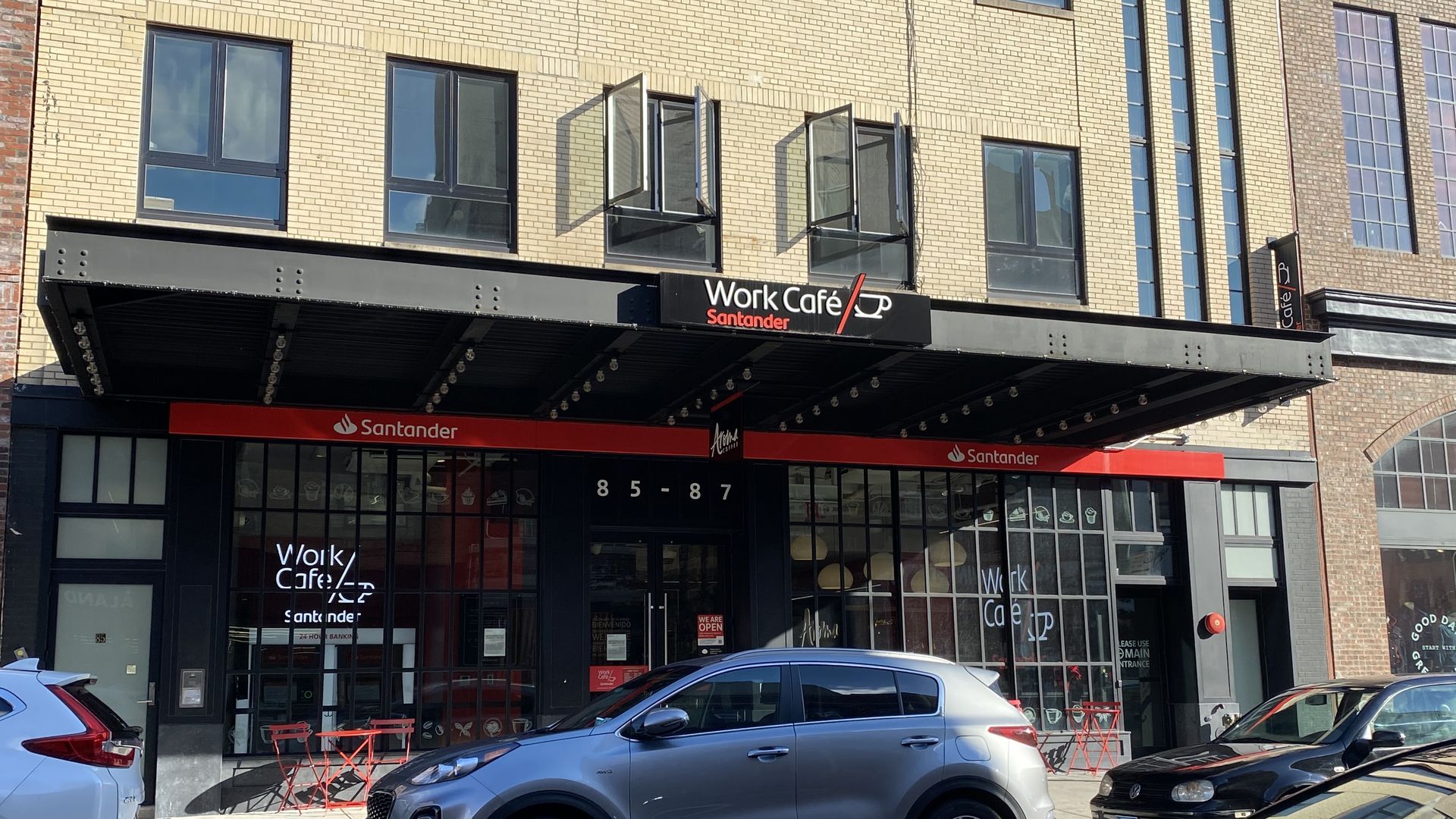| | | | | | | | | | | Axios @Work | | By Erica Pandey ·Jan 06, 2021 | | Welcome to the first 2021 edition of @Work. - What do you want to read about this year? Send your thoughts to me at erica@axios.com or hit me up on Twitter @erica_pandey.
I've got 1,528 words for you — a 6-minute read. Let's jump in with... | | | | | | 1 big thing: Why business travel matters |  | | | Illustration: Eniola Odetunde/Axios | | | | Gone are the days of jet-setting for work. Even as we return to offices, the pandemic's effect on business travel will likely last. Why it matters: The fate of business travel has big ramifications for the economy at large. Its decline could cost millions of jobs, shutter even more small businesses and make your next vacation more expensive. Driving the news: Business travel will drop by up to 36% in the post-pandemic world, according to a Wall Street Journal analysis that individually examined different categories of travel, like sales, conventions and intra-company meetings. - Bill Gates is even less optimistic. He recently projected business travel would decline by more than 50%, saying there will be a "very high threshold" for trips now that salespeople, consultants and others have shown that they can do their jobs without traveling. On top of that, cutting business travel saves companies lots of money.
- "Basically, no matter what we do, this pandemic has wiped out a chunk of business travel," says Charlie Leocha, president of Travelers United, a passenger-advocacy organization, and one of the architects of the Journal's analysis. "That is a big problem for the airlines."
The stakes: Business travelers only make up around 10% of airline passengers across the major global carriers, but they account for 55%–75% of revenue because they're typically the ones who spend big on last-minute tickets or book premium seats, the New York Times' Jane Levere reports. - In 2020, the business travel industry — which encompasses airlines, rental car companies, hotels and more — lost nearly a trillion dollars, according to the Global Business Travel Association, a trade group with around 9,000 members.
- The industry also laid off millions, and many of those jobs will disappear forever as business travel sees a permanent setback.
Fewer business trips will also affect leisure travel. "Airlines losing business traffic is going to change the dynamic for all of us," says Leocha. - Less choice: Airlines could reduce the number of domestic and international routes.
- Higher fares: With fewer business travelers bringing in revenue, ticket prices could go up for everyone else.
There are some bright spots for the industry. While certain types of business travel — like flying in for meetings with colleagues from other cities — are expected to fall away, other types — ones that drive sales or help secure new clients — will continue in the long run, experts say. - Steve Black, co-founder at Topia, an HR tech company, tells Axios chief transportation correspondent Joann Muller that he expects an "arms race" in the return to travel for sales teams. "The first time my competitor is in the room pitching, I'm getting on a plane. I guarantee you," he says.
- Singapore's Changi Airport is betting big on the return of travel, including business trips, per Bloomberg. It's adding 840 guest and meeting rooms at a nearby complex and building "glamping" sites for families.
|     | | | | | | 2. What I'm watching in the telecommuting tech world |  | | | Photo illustration: Aïda Amer/Axios. Photo: GraphicaArtis/Getty Images | | | | As we head into another year of working remotely, the work-from-home tech space is getting more crowded — and creative. What's happening: Existing remote work tech battles are intensifying, and new players are coming in, promising to save people from Zoom and Slack fatigue, by offering something fresh. The big picture: "2020 was all about solving the first-order needs," says John Goulding, CEO of Workvivo, a workplace app that combines a social media format with the communication features of something like Slack or Microsoft Teams. - "It was about making sure people had the right video technology and making sure people were able to share files and documents and get work tasks done."
- Now organizations are starting to think about how they can move beyond the bare minimum.
What I'm watching this year: - Messaging fight: Slack had a rough start to the first workday of 2021, with a Monday morning outage that caught the attention of millions of workers who are now relying on the platform. I'll admit there was a moment when I was unsure how else to contact my colleagues (ended up sending email).
- Beyond just fun backgrounds: Cisco's WebEx upped its game this week with a slew of new features for its videoconferencing software, including a function that spits out meeting highlights on verbal command and a way to flit between a phone call and a video call. There are even custom versions of WebEx, including one for legislative bodies to conduct government business virtually.
- Look for other videoconferencing platforms like Zoom and BlueJeans to roll out new features this year, too.
- Adding back the human connection: Virtual meetings and gatherings are devoid of the magic of being together in person, and while technology will never be able to solve for that fully, there's room for more innovation, Axios chief technology correspondent Ina Fried notes.
- "Imagine, for example, an app built for birthday parties that offered kids some interactive fun — anything from a digital version of pin-the-tail-on-the-donkey to built-in-access to Super Mario or Minecraft. One can easily envision adult-themed possibilities as well."
|     | | | | | | 3. A new kind of union |  | | | Illustration: Sarah Grillo/Axios | | | | With this week's announcement that some Google employees have formed the Alphabet Workers Union, the tech industry is getting its own innovative take on labor organizing, Ina writes. Between the lines: On the one hand, this isn't a traditional union — it won't be able to collectively bargain or formally represent the workforce. - At the same time, the new "minority union" offers a fresh approach to solidarity: It's open to some managers and can represent temporary and contract workers.
The big picture: Google has faced a rising tide of dissent in recent years, as employees have staged walkouts and spoken out on everything from sexual harassment to the company's work for the military to the recent ouster of prominent AI ethics researcher Timnit Gebru. What "minority unions" can do: - Collect dues (in this case 1% of an employee's cash and stock compensation), elect officers and hire paid staff.
- Publicly lobby for workers' goals.
- Include workers from across the country and across job types, including workers and managers, full-time employees and contractors.
What they can't do: - Bargain collectively for a contract.
- Officially represent Google's workforce.
Worth noting: Tech workers, for the most part, are paid more than those in other industries and don't face the kind of physically hazardous conditions that have often driven labor organizing in the past. - The discontents that Google union organizers are expressing have more to do with what they see as a gap between the company's ideals and some of its actions.
Go deeper with Ina's full analysis of what this means for Silicon Valley. |     | | | | | | A message from Axios | | AxiosHQ: A better way to communicate with your employees | | |  | | | | What's new: AxiosHQ is a simple writing tool — perfected by Axios writers and machine learning — that helps you write with clarity and efficiency. - It includes tips to improve your internal communications, such as how to write a headline that grabs your employees' attention.
Learn more. | | | | | | 4. Some good news: Pay bumps for America's essential workers | | Twenty states increased their minimum wages starting this year, which means raises for scores of lower-wage workers across the country — many of whom have been doing essential jobs throughout the pandemic. Details: - "In California, the rate for employers with 26 workers or more will rise from $13 to $14 an hour, the highest state-wide baseline in the country," writes CNN Business' Alicia Wallace.
- New Mexico had the most dramatic hike — up $1.50 from $9 to $10.50 an hour. And Minnesota had the most modest one — up 8 cents to $10.08.
The bottom line: The federal minimum wage still sits at $7.25 an hour. |     | | | | | | 5. Worthy of your time |  | | | Illustration: Aïda Amer/Axios | | | | New woes for the unemployed in 2021 (Axios) - Tens of millions of Americans who arguably need tax refunds the most will wind up financially short for yet another year. People who collected unemployment will receive smaller — or nonexistent — refunds this coming year because of a tax law quirk that counts unemployment as taxable income.
How the pandemic exacerbated finance's gender gap (Institutional Investor) - When schools were closed this year, female analysts were far more likely to get pulled away from work due to child care and household responsibilities than their male counterparts, new research shows.
Real estate giants are awaiting the return to work (Wall Street Journal) - White-collar workers who are telecommuting are leaving New York and San Francisco, causing rents to fall by double-digit percentages in those cities. At the same time, rents in places like Stamford, Connecticut, and Sacramento, California, are on the rise. Real estate companies that have placed big bets in big cities are counting on the return to offices to bring tenants back.
The pandemic pushed millions of older workers to retire early (CNN Business) - While the labor force participation rate among young workers has nearly bounced back to pre-pandemic levels, the rate among older workers is still lagging. Older workers are weighing more severe health risks when thinking about returning to work — and they're far less likely to jump back into the labor force after a long hiatus, choosing early retirement instead.
|     | | | | | | 6. 1 fun thing: The rise of third workplaces |  | | | Photo: Erica Pandey/Axios | | | | As I wrote to close out 2020, the popularity of hybrid remote/in-person working will give rise to "third workplaces" — places to take calls, attend meetings and write memos that aren't your home or your office. The big picture: Once the pandemic is behind us, people will still want the flexibility of remote work, but they'll also want to escape their homes. - Look for coffee shops, retailers, hotels and even banks to jump on this trend and open up mini work areas or cafes where people can drop in or reserve space to work for a few hours.
- I saw one example pop up while walking around Williamsburg, Brooklyn, this past weekend. Santander Bank has opened up a "Work Cafe," pictured above, which serves food and coffee and offers seating and WiFi to telecommuters. The bank has tried the concept in other countries, but this is its first U.S. location — and it was opened a couple of months ago, in the middle of the pandemic.
Go deeper: WeWork wants to be the Uber of offices |     | | | | | | A message from Axios | | AxiosHQ: A better way to communicate with your employees | | |  | | | | What's new: AxiosHQ is a simple writing tool — perfected by Axios writers and machine learning — that helps you write with clarity and efficiency. - It includes tips to improve your internal communications, such as how to write a headline that grabs your employees' attention.
Learn more. | | | | Thanks for reading! | | | | Axios thanks our partners for supporting our newsletters.
Sponsorship has no influence on editorial content. Axios, 3100 Clarendon Blvd, Suite 1300, Arlington VA 22201 | | | You received this email because you signed up for newsletters from Axios.
Change your preferences or unsubscribe here. | | | Was this email forwarded to you?
Sign up now to get Axios in your inbox. | | | | Follow Axios on social media:    | | | | | |








No comments:
Post a Comment